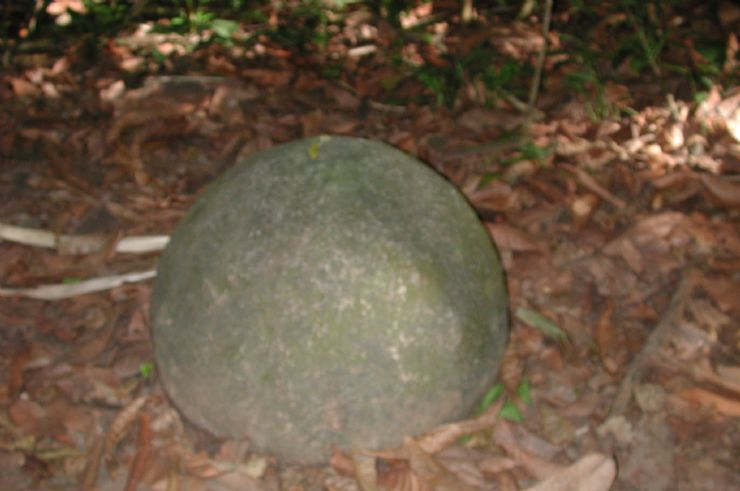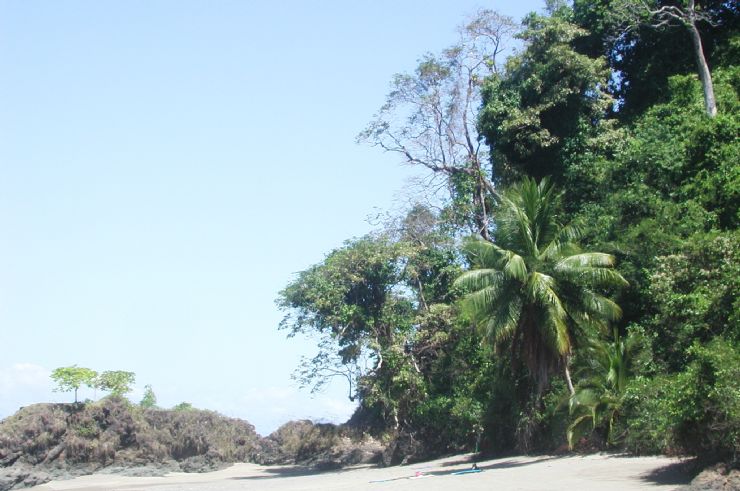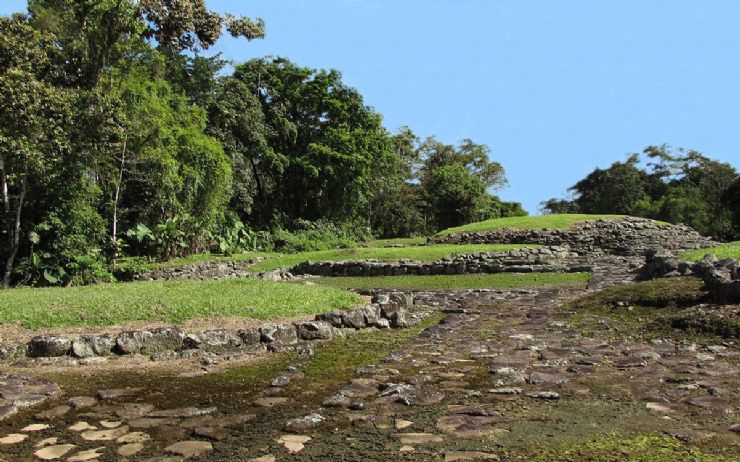
Pre Columbian Rock Sphere, Isla Del Caño
My country is known for being a place of diversity, natural wonders, and mystery. Some of these legends are so shrouded in the unknown that even my family’s frog tales, passed down for generations, don’t provide details. One of the most intriguing mysteries of Costa Rica is the stone spheres that appeared in the Diquis Delta, somewhere around the mid 1900's.
What Are the Stone Spheres?
You might thinking that I’ve hopped onto the crazy train by saying that one of the most interesting things in Costa Rica are these stones; I mean Costa Rica is home to more species of flora and fauna then we can count, and, hello, cloud forests. I agree that those things are definitely interesting, but let me tell you more about these stones before you commit me. First of all, this is no small group of rocks; this is a group of over three hundred man-made spherical stones. Three hundred! The first time I saw them, I was just in awe; and I’ve seen a lot of wondrous things in Costa Rica throughout my travels. Some of the stones are small, and some of the stones are large. The largest stones measure at over 6 ft. in diameter, and can weigh over 10 tons. While most of the stones are of the same material – gabbro – some of them are made from limestone or sandstone.
There is speculation among scientists regarding the nature of the stones’ creation; the most popular theory is that they are manmade, though some do believe that they were formed naturally in the bed of the Terraba River. The trip from the river would be over 50 miles, though, so many contest that theory. Scientists aren’t able to accurately date the stones since they have been moved from their original location, though it is believed they are from a time period between 200 BC and AD 1500.

Isla del Caño Beach
Where Are the Stone Spheres?
The stones, called Las Esferas de piedra, which means The Stone Balls, have been discovered in many locations, including locations on Isla del Caño and on the Diquis Delta. The Diquis Delta is located in southern Costa Rica, in the province of Puntarenas, and this area is home to the excavation sites for the stones. There is a series of excavations, known as Palmar Sur Archeological Excavations that cover about 10 hectares. The United Fruit Company previously owned this property. The most popular of these sites is called “Farm 6,” which was a settlement that included sculptures and architecture, in addition to a cemetery. This sites is dated from 300 – 1550 AD, which covers the Aguas Buenas Period and the Chiriqui Period. This site has kind of becoming a parking lot for many of the spheres.
7 Days / 6 Nights
Starting at $779 per person
How Were the Stone Spheres Created?
If only I had the answer to this question! I’d gladly share it if I knew. Unfortunately, they are and probably always will be a mystery. Though sometimes described as perfectly round, this is not entirely true (though they are near perfect, rating at around 96% perfect). Some think that they spheres were perfect, but that time and erosion have made this impossible to ever prove. However, they have an impressive shape; one that makes it seem logical that some sort of machine or mechanical process must have been used to achieve such accuracy. Scientists have used other structures from the same time period to examine the skill of the culture and people, and have concluded that they did seem to be advanced sculptors. Because of their shape and their smooth surface, it is believed that the ancient culture used a method of extreme heat, cooling, and polishing to achieve their shape and finish. We also know, from the accuracy of the shape, that these people must have been skilled mathematicians. Though great with numbers, they hadn’t quite developed written language, and so they were not able to record their process for how, and why, they created these stones. The other mystery of how these stones were created involves the material used to make them. They were made of several materials; some of granite, some of coquina. What’s crazy about that is that the granite would not have been easy to access. It was miles away, about 30 miles away. Even all my ancestors together at once couldn’t move that material 30 miles! Don’t forget that some of these stones weigh more than 15 tons. So that is 15 tons that would have to be moved 30 miles, without modern technology or machines. It could have been done if the natives were very dedicated and spent time in the bush cutting some very big tracks, but even that seems like an unending task. The coquina is a little more feasible to think about, as it was likely found on the banks of the river. Those of the civilization likely rafted that material up the river, and brought it to its final destination.
Why Were the Stone Spheres Created?
The stones are dated to have been created before the Spanish conquest, but the people and the culture that knew what the stones were and why they were, disappeared after the conquest, and took their knowledge with them. Observation and speculation mixed, it is said that the spheres could have represented tribal rank, religious ceremonies or symbols, or even burials plots. All that modern culture is left with are educated guesses; though some of the guesses are more like myths. As is natural with something that invokes such a sense of wonder, many myths are associated with the stones. Some say that the stones come from Atlantis, which itself is a myth. Others believe that the stone spheres are simply a creation of Nature herself. Still others believe that the ancient cultures were able to create a potion that softened rock so that it could be molded into spheres. Of course, none of these theories have a foundation of evidence to work off of as yet.
There are also myths that an ancient god shot the balls down from the heavens as a way to drive its enemies from the lands. Some believed that the spheres were filled with things, like a single bean of coffee, or with treasure, like gold. There are even some scientists that have speculated the journey to complete these stone spheres too over 1,500 years. There is also some speculation about how the stones were found to be placed. They were sometimes found in groups or clusters; sometimes in straight lines, sometimes in curved lines, sometimes in triangles, sometimes in parallelograms. These geometric shapes strangely seemed to point to the magnetic north of Earth; but that is crazy, right? How could these ancient people have accurately determined, with accuracy, Earth’s magnetic north?
The shape of the stones are also up for question. Are we seeing them in their true shape, or have they been misshapen by nature? Were they once near perfect are they even near perfect now, or was the data, research, and measurements inaccurate? To this day, research continues to try to answer all of those questions. And boy, would I love to have all the answers.
The Stones in Modern Culture
The stones first found their way into modern culture in the 1930's, when some jungle land was being cleared by the United Fruit Company, so that they could cultivate plantations for bananas. The spheres were not immediately thought to be significant historical pieces, as it their shape led the workmen to believe that these were just some man-made stones. Thinking they were basically just an annoyance, the workers used their heavy-duty machines to kind of toss the stones aside. This not only uprooted the stones from their location, but for some stones it also resulted in damage. After a time, there were some that believed that there was gold or treasures hidden inside of the stones, and they wanted to find it. Many stones were drilled into, then blow up with dynamite. Others were just smashed. Time after time, there was nothing discovered inside of the spheres. Many of the mysterious stones were completely destroyed before Costa Rican authorities and historians stepped in to protect the stones. Though some have been put back together and are on display in San Jose at the National Museum of Costa Rica, they have been permanently damaged. Even so, there are over 130 stone spheres that have been officially cataloged by the museum. Of course, there are many more spheres in existence around my country that have not been cataloged. Some of these spheres will never be cataloged, unfortunately, as they have been extracted from their original locations by those that now use them as a private decoration in their home, garden or church. There are still some spheres out there that have yet to be discovered! Maybe I’ll come across some in my travels around Costa Rica! After the stones were discovered, and their destruction was halted, scientific exploration of them started. After the findings were published, even more attention was drawn to the spheres, included the eye of Samuel Kirkland Lothrop, who worked at Harvard University in the Peabody Museum, and, later, a researcher from Kansas named John Hoopes. Lothrop visited Costa Rica in 1948 to work on an unrelated project, but after meeting a valuable contact, he was directed to the spheres. He later published his findings, in 1963.
After his work, there was not too much movement on research of the spheres for over 40 years. It wasn’t until the 1990's that research resumed. A new set of researchers attempted to determine the age of the ceramics that were found in the region. To do this, they did examinations of the drainage ditches, and they were able to conduct research on settlement patterns and more that gave them a glimpse into the culture of these ancient, stone-creating people. More recently, since the early 2000's, a new team of archeologists have been conducting continuous research. They are attempting to focus on the cultural significance of four main sites: Grijalba, Batambal, El Silencio, and Farm 6. Through their work, they are also protecting the heritage of the culture that created the stones, and working to begin the first thorough examinations of the sites. Tourism for archeological sites hasn’t quite become a popular activity in Costa Rica, though there are some spots that are progressive, such as the monument of Guayabo in Turrialba. The spheres, however, attract enough attention that the main archeological site, Farm 6, is open for appointmentbased tourism.

Guayabo National Monument
Where Can You See the Stones?
Your Costa Rica is sure to be jam packed with exciting adventures, like hiking and canopy tours, but if you are as intrigued by the spheres as scientists and tourists have been, you should be sure to fit in a trip to see them in person. The stones are scattered in many places nowadays, including monument set ups in front of buildings and grassy areas. These spheres can be found all the way north in the Estrella Valley and as far south as the mouth of the Coto Colorado River. Although there are a couple in exhibits at places like the National Geographic Museum and Harvard University, seeing them in their native land is much more fun!It was very rare, but a few stones were even found with carvings in them. Some think these were created as a game, but other experts believe the carvings represent constellations in the sky. There is one stone with a carving that is almost an exact correspondence to a star chart of the constellations. The alignments of some of the stone patterns were created with a high degree of mathematics and measurement.
Maybe one future visitor will be able to crack the code?No matter what you decide to do in Costa Rica, one thing is for sure: my home country is sure to impress you. Whether it is our flora, fauna, amazing landscapes, activities, or mysteries like the spheres, you are sure to find wonder and amazement during your stay.

